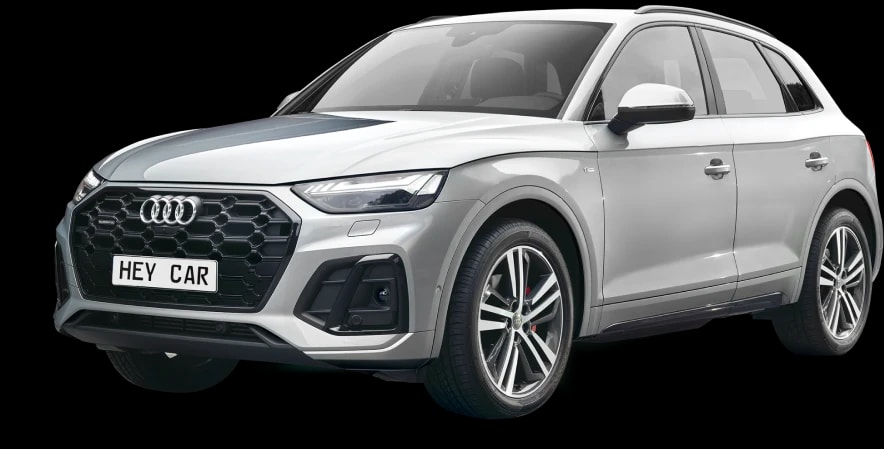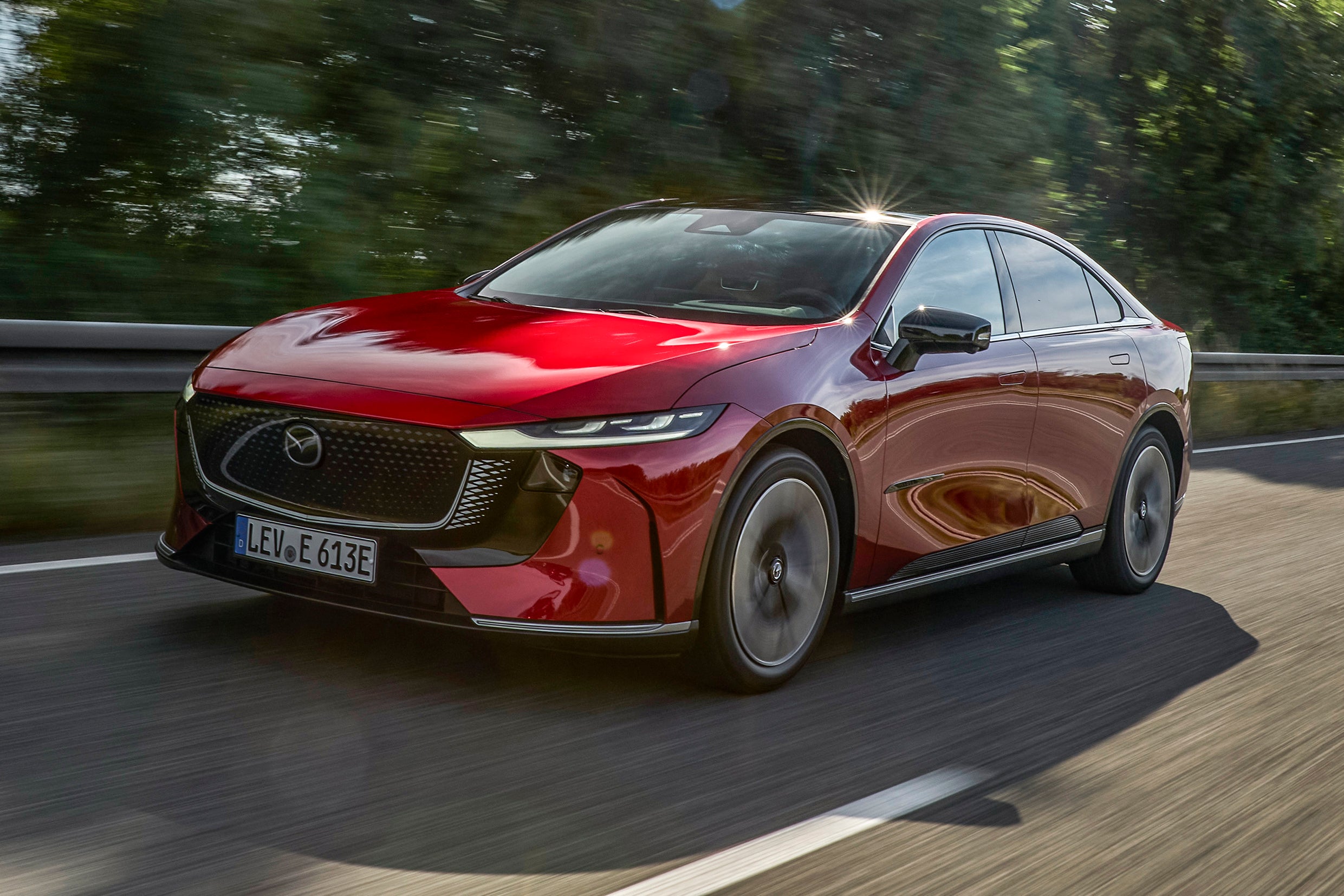Mazda 6e Review 2025: Price, specs & boot space
Written by Ivan Aistrop
- 2026
- Hatchback
- EV
Quick overview
Pros
- Cabin feels genuinely plush
- Pretty good on practicality
- Decent driving experience
Cons
- We can’t be sure that ride comfort will pass muster in the UK
- Touchscreen infotainment
- Woeful rear visibility
Verdict: Is the Mazda 6e a good car?
"During the bygone boom years of the family saloon/hatchback, before the family car market was taken over by SUVs, the Mazda 6 was a very popular choice thanks to its impressive practicality, strong quality and enjoyable driving experience. All those things remain with the latest incarnation of the car, but nevertheless, you might not recognise it as a Mazda. Find out why in our Mazda 6e review."
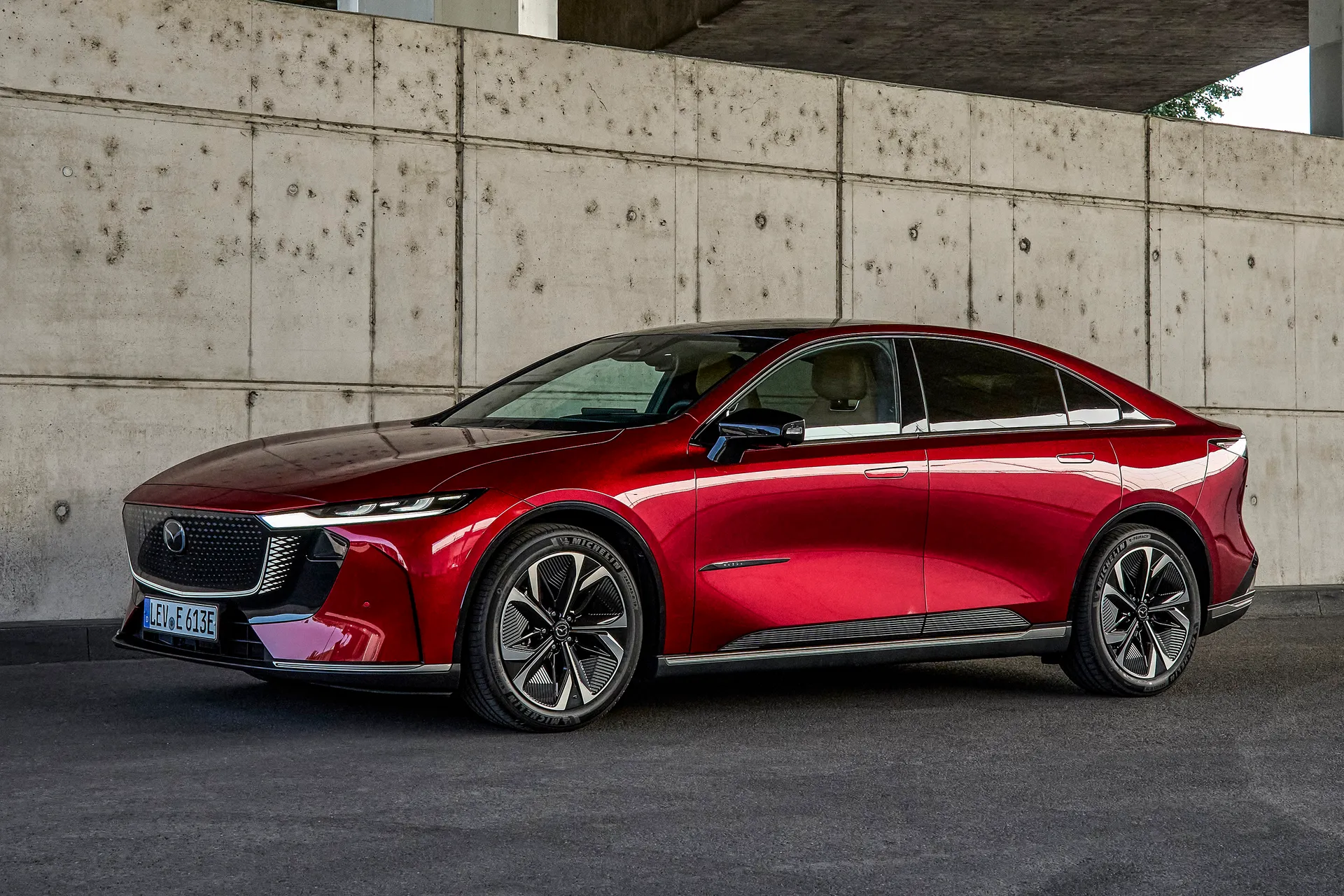
For starters, as the name suggests, it’s all-electric. Not a first for Mazda, but a first for the 6, and to be fair, it’s not an entirely unsurprising development considering the direction that the car industry is currently heading in.
No, where the 6e differs to every Mazda that has gone before it is on the inside. The impressive quality is still there (it’s more impressive than ever, in fact), as is the family-friendly practicality, but it’s the interior design that’s done a complete about-turn.
You see, in recent years, while other manufacturers have been rushing to purge physical switchgear from their cars’ interiors in favour of touchscreen tech that’s more fashionable and cleaner looking (not to mention cheaper, coincidentally…) Mazda has been very vocal about its opinion that touchscreen technology is not suitable for use in cars because it's too distracting. And that’s a view that we happen to agree with.
Well, it seems like the interior designers of the Mazda 6e didn’t get the memo. Look around the cabin, and other than the window switches on the doors, and the buttons on the sides of the electrically adjusting seats, you’ll not find a single piece of physical switchgear. Instead, you’ll find a whopping 14.6-inch central touchscreen through which pretty much all the car's functions (even the windscreen wipers: we kid you not!) must be operated. Given the firm’s previous position, and the passion with which they preached it, it’s quite the climb-down.
And yes, this has had the detrimental effect you’d expect when it comes to ergonomics. Too many functions are buried too far down in too many menus and submenus. It’s a real shame.
We might be able to offer a possible explanation for this sudden change of heart. While touchscreens are very popular here in Europe, they’re absolute must-haves in China, and the 6e is actually the product of a joint development between Mazda and Chinese company Changan Automobile. The car has been on sale in China as the Mazda EZ-6 since mid-2024, and it also lends its mechanicals and tech to two other models, the Changan Nevo A07 and the Deepal L07.
And there is a slightly Chinese feel about the 6e. Where Mazdas are usually engineered with the joy of driving in mind, the 6e feels tech-led, like more of a say over the final product was given to software developers rather than engineers. And as a result, it feels a bit clinical. Not bad, you understand, just clinical.
Of course, while this will annoy die-hard Mazda fans, the vast majority of people won’t care less. As long as it looks nice inside and out, is big enough to fit in the family and their stuff, goes a decent way on a charge, does so comfortably and quietly, and is priced right, there shouldn’t be any barrier to customers parting with their cash (other than the endless sea of tempting SUV-shaped alternatives, that is).
On the strength of what we’ve observed during our drive of a pre-production prototype in Germany, the 6e seems to have almost all those boxes ticked, happily. The only one that remains unchecked is the one concerning price, because it doesn’t go on sale in the UK until midway through 2026, so the price is yet to be decided. And it’ll be an important decision, because we can see this being crucial to the 6e’s level of success.
Is the Mazda 6e right for you?
Hmm. Tricky one, that. It’s probably going to come down to how much Mazda charges for it, which is one key piece of information that we’re still in the dark on. Large all-electric family-size hatchbacks like this are usually pretty pricey, with most of the direct rivals starting at around the £50,000 mark. If Mazda can undercut that by a significant amount, then it’ll look very tempting, and you might be prepared to overlook some of the car’s annoyances in order to save cash. We’ll just have to see once pricing becomes available.
What's the best Mazda 6e model/battery to choose?
As we’ll find out in a while, the Mazda 6e’s two powertrain offerings are a little bamboozling. One has a decent range and decent DC rapid-charging capability, while the other has a slightly longer range, but a much worse rapid-charging capability, yet costs more. So it kind of depends how you’ll use your car. If you can live with the shorter-range model - which we think most can because it’s still useful at 298 miles - then we’d probably stick with that.
What other cars are similar to the Mazda 6e
Not many, is the answer to that. While large family hatchbacks were once all the rage, they’ve now been overtaken by SUVs in the affections of family car buyers, and very few remain as a result. Even fewer exist in all-electric form.
The most direct rivals we can see are probably the Volkswagen ID.7, which is a similar size and shape, and maybe the Hyundai Ioniq 6, which is a similar size, but a rather different shape, and has a saloon boot rather than a hatchback one. The forthcoming Volvo ES90 could be added to the mix, although that’s likely to be a lot more expensive. Otherwise, electric family hatchback/saloon offerings tend to be a little smaller. We’re thinking of cars such as the BYD Seal, Tesla Model 3 and BMW i4.
Comfort and design: Mazda 6e interior
"You’ll find it easy to get comfortable at the steering wheel of the Mazda 6e, because the driver’s seat has a good range of full electric adjustment, and there’s a decent amount of travel in the manually adjusting steering wheel."

It’s a little odd that the passenger seat doesn’t have height adjustment included with its repertoire of electric adjustment, but that’s no biggy.
No matter what you do with the driver’s seat adjusters, though, you won’t be able to remedy the 6e’s absolutely woeful rear visibility. The rear window is shallow, narrow, steeply angled, and has thick pillars either side of it, all of which conspire to give you a really poor view out. Our high-spec test car had all-round parking sensors and 360-degree cameras, and for this reason, we really hope these are standard across the range, because you’ll definitely need them.
Quality and finish
This is an area in which the Mazda 6e really impresses. In front of you sits a dashboard that’s finished with soft-feel stitched leather and several flashes of chrome, while the doors either side of you get a similar treatment, coccooning you in lustrous materials and tasteful finishes.
The hard plastic hub of the steering wheel isn’t quite in-keeping with the rest of it, mind, and neither are the harder plastics that you’ll find if you delve down into the lower reaches of the cabin, but these are mainly tucked away out of sight, and neither is enough to betray the car’s overarching feeling of sophistication.
Infotainment: Touchscreen, USB, nav and stereo in the Mazda 6e
For many years, Mazda has largely shunned the use of touchscreen technology in its products, proclaiming - vocally and vociferously - that the tech isn’t fit for purpose in cars because it’s too distracting. And as such, the firm has, in recent years, defiantly persisted with the buttons, switches and dials that pretty much all other carmakers have been in such a rush to abandon in favour of touchscreen alternatives. And we’ve applauded them for that, because theirs is a view with which we wholeheartedly agree.
Well, it seems that this view is one that Mazda no longer holds for some reason. Cast your eye out over the 6e’s cabin, and you’ll find virtually no switchgear. You still have electric window switches on the door grabs, buttons to move your electrically adjusting seats, plus a catch to open the glovebox, but that’s about it. Pretty much everything else is operated through the large 14.6-inch touchscreen in the middle of the dashboard. It’s a complete about-turn - and something of an embarrassing climb-down - for Mazda.
Even adjusting your door mirrors involves selecting the correct menu option, from literally dozens on offer, and then using arrows buttons on the steering wheel to make the adjustments. Perhaps even more ridiculously, turning on the windscreen wipers requires touchscreen interaction: again, you have to pick out the correct menu option, and then select your wiper speed. What was wrong with flicking a stalk behind your steering wheel?
These are two extreme examples of touchscreen over-reliance, but generally, the system isn’t easy enough to use. The ecosystem of menus, submenus, widgets and checkboxes is too complex to navigate reliably, so finding the function you need is difficult and time-consuming. The sensitivity of the screen isn’t brilliant, either, so often, instructions have to be repeated numerous times before they register. Okay, so there’s voice control and gesture control to act as alternative interfaces, but these work about as well as they usually do: poorly, in other words.
As well as the central screen you have a head-up display projecting important driving information onto the windscreen in front of you, plus a 10.2-inch digital screen behind the steering wheel presenting much of the same information, plus a bit more. The former is fine, but the latter looks cluttered.
The system has DAB radio, navigation, wireless phone charging, three USB ports, a 14-speaker Sony sound system.
Space and practicality: Mazda 6e boot space
Like with most cars, you won’t want for space up front, and there’s a variety of different storage points to keep your odds and ends in.
In the rear seats, you’ll find lots and lots of kneeroom, which isn’t entirely surprising given the generous size of the car. For those interested, the 6e is 4,921mm long, 2,156mm wide (including mirrors) and 1,491mm tall.
Headroom in the back isn’t in quite such generous supply, probably due to the panoramic roof fitted to our test car, and anyone much over six foot tall will run the risk of messing their hairdo up on the ceiling. And that’s for those in the outer two seats: headroom is even tighter for whoever sits in the middle because their seat base is raised a little compared to those either side. They’ll be comfy if they’re not too tall, though, because the middle seat is wide - as is the entire cabin, so there’s plenty of shoulder space for three across the back - and there’s a flat floor in front of it.
Mazda gives the 6e’s boot space at 336 litres up to the parcel shelf, or 466 litres up to the roof, including underfloor storage. We’re a little confused by this, though, because the under-shelf space looks much, much bigger than stated, and there doesn’t look to us to be an extra 130 litres-worth of space when loading up to the roof due to the steep angle of the rear window, even when you factor in underfloor space, of which there was precisely zero.
We can only think that there must be some anomaly over how the space is measured in the Chinese market from which that car hails, that doesn’t line up with European measuring standards. Whatever the case, just know that in real life, the 6e’s boot is a very decent size, and most families will find it more than adequate.
Access to the space is also very good thanks to the hatchback tailgate, and there’s only a small lip to lift items over when loading. We’ve already mentioned that there’s no underfloor storage, but fear not: there's a large additional storage space of 72 litres under the bonnet that’ll take your charging cable, along with a piece of carry-on luggage.
The rear seats fold down in a 60/40 split to boost your cargo-carrying capacity up to 1,074 litres (although we suspect that luggage capacity figure to be about as reliable as the other ones, and although the backrests don’t quite sit flat and level, they’re not far off.
Handling and ride quality: What is the Mazda 6e like to drive?
"Mazda has a reputation for building cars that handle well (sometimes to the detriment of ride comfort) to deliver an enjoyable driving experience. If we’re honest, the 6e doesn’t quite feel like a traditional Mazda, but it does do a fairly decent impression."
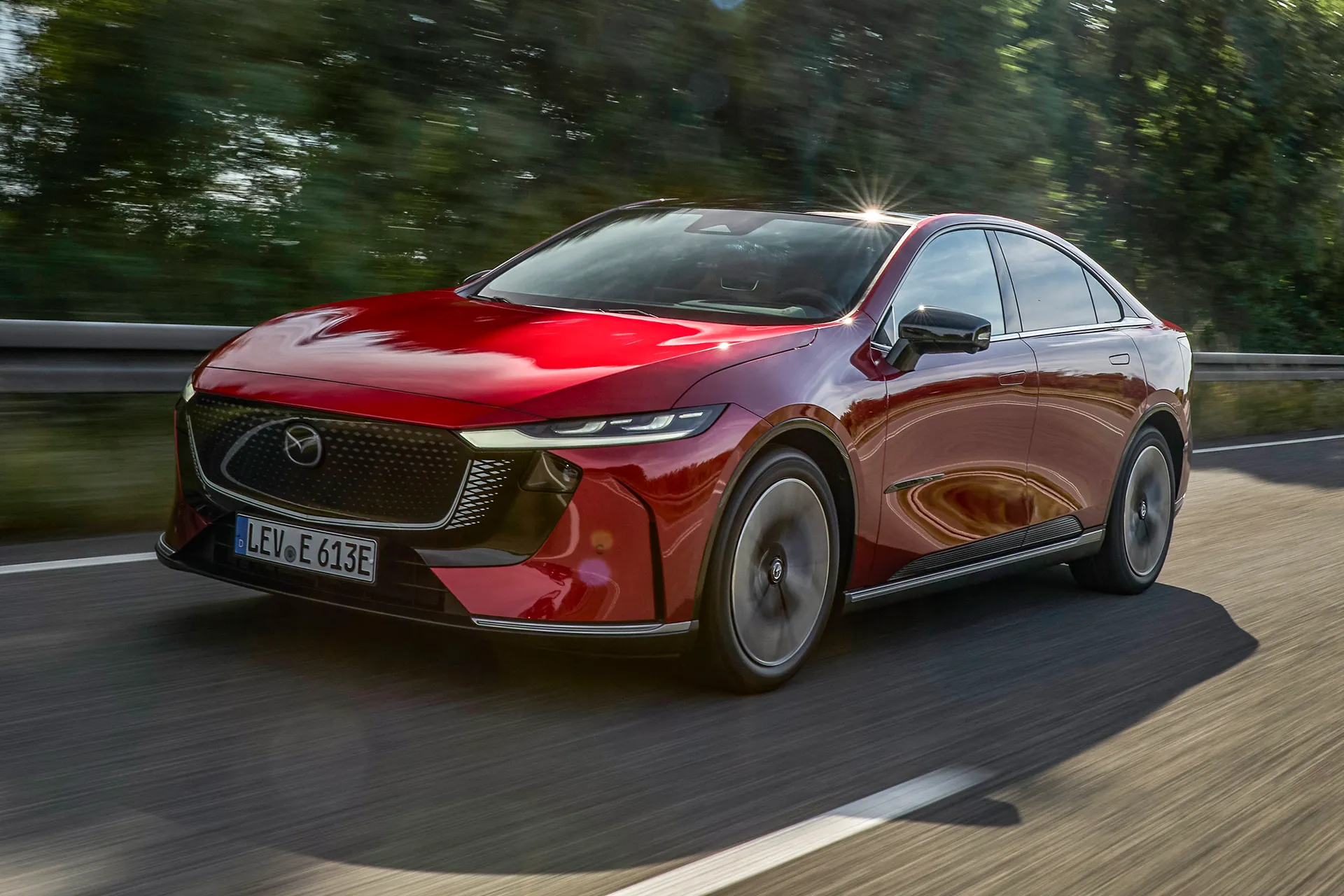
The weight of the car - almost two tonnes - prevents the 6e from having that pointy, playful, flyweight feel of many other Mazda models, but nevertheless, it masks its weight pretty well and feels very tidy in the bends. Body control is tight, grip is strong and the steering is fast and responsive, and all of this makes the car feel very eager to turn. For everyone except true Mazda die-hards, this will be an enjoyable car to drive daily.
With ride comfort, things are a little less clear. We sampled the car on roads around Leverkusen in Germany, roads which had about as many corruptions as a nun who’s just won ‘employee of the month’. The car stayed effortlessly comfortable and civilised as a result, but even despite the unblemished nature of the surfaces beneath us, we still detected an underlying brittleness that made us wonder how the car would fare on the rather-less-immaculate roads of the UK. We’ll have to sample a car over here before we deliver chapter and verse on comfort levels, so until we do, we’ll leave it there.
What motors and batteries are available in the Mazda 6e?
There are two versions on the Mazda 6e, the Standard Range and the Long Range, and which you choose determines the amount of power you get. The strange thing is that the numbers involved are barely any different, so you kind of wonder why Mazda has bothered.
The Standard Range car has a 258PS motor driving the rear wheels, fed by a 68.8kWh battery. It does 0-62mph in 7.6 seconds, and does 298 miles on a charge, according to official figures.
In the Long Range car, the motor is still rear-mounted, but power is dropped slightly (and we really do mean slightly) to 245PS, and correspondingly, the 0-62mph time is extended to 7.8 seconds. Hardly a massive difference, then. The upside is the bigger 80kWh battery, which extends the range to 343 miles.
The pre-production prototype we drove was a Standard Range car, and the sensation of performance you get feels every bit as average as the numbers suggest. Like most electric cars that don’t have bonkers amounts of power, the initial response to a prod of the accelerator pedal feels very strong indeed, making it feel decidedly sprightly when pulling away, but once you’re up and running at a decent lick, the level of acceleration you feel tapers off quite a bit. Still, it’ll be plenty quick enough in all situations for the majority of potential buyers.
If you’re an EV driver that likes their car to have a one-pedal driving mode, then the 6e won’t be for you. The regenerative braking can be adjusted in four stages, but even the most vigorous of them isn’t particularly, well, vigorous. You also don’t have paddles behind the steering wheel to switch between modes: this has to be done on the touchscreen. Of course it does…
Mazda 6e range: How far can you travel on a charge?
The Standard Range car has a 68.8kWh battery pack that, according to official WLTP combined figures, will take you up to 298 miles on a full charge. It also has a DC rapid charging of 165kW, meaning a 10-80% top-up can theoretically be delivered in 24 minutes.
The Long Range version has a larger 80kWh battery, making it good for a range of 343 miles according to official stats. However, the DC rapid charging speed is bizarrely dropped to 90kW (Mazda says that this is designed for those who mostly charge at home and only use public chargers in emergencies, and anyone that uses rapid chargers more often should choose the Standard Range version), so the same 10-80% juice-up will take at least 47 minutes.
In both cases, we’d bank on getting at least 10-15% less in the real world, even in seemingly perfect conditions. When you hit the motorway, or the weather turns cold, expect to lose a good slice more range. At least the standard heat pump should help preserve your range in colder conditions thanks to more efficient cabin heating.
Refinement and noise levels
This is perhaps the area in which the Mazda 6e is most impressive. Obviously, the electric motor propels the car on with very little in the way of sound, which you’d expect from an electric car, but in the 6e, road noise is also very well contained (not always the case in other Mazda models we’ve driven, and wind noise is also extremely well isolated, and that’s despite the fact that the side windows are frameless. Whether you’re tiptoeing through town or blatting along a motorway, this is an extremely quiet and relaxing way to do it.
Safety equipment: How safe is the Mazda 6e?
Mazda says it’s aiming for a five-star Euro NCAP crash test score with the 6e, which is a fairly pointless thing to say, because we’re sure everyone aims for a top score. Whether it’s achieved or not is another matter entirely.
In order to achieve this feat, expect the car to come with a wide variety of driver aids. UK specifications haven’t been released yet, but cars are already available to order in Germany, and these are advertised as having the following as standard: adaptive cruise control with traffic jam assistance, attention assistance, traffic sign recognition, speed warning, rear cross traffic alert, front- and rear collision warning with autonomous braking, lane keep assistance, lane departure warning, and door opening warning.
If that little lot isn’t enough to prevent you from having a crash in the first place, there are no fewer than nine airbags to help keep you and your family from harm.
Mazda 6e charging times: How much does it cost to charge?
"The 6e has a maximum AC charging speed of 11kW, and as such, Mazda quotes charging times at 7.3 hours for the Standard Range Car and 8.4 hours for the Long Range. Don’t expect your home hookup to deliver a charge that quickly, though."
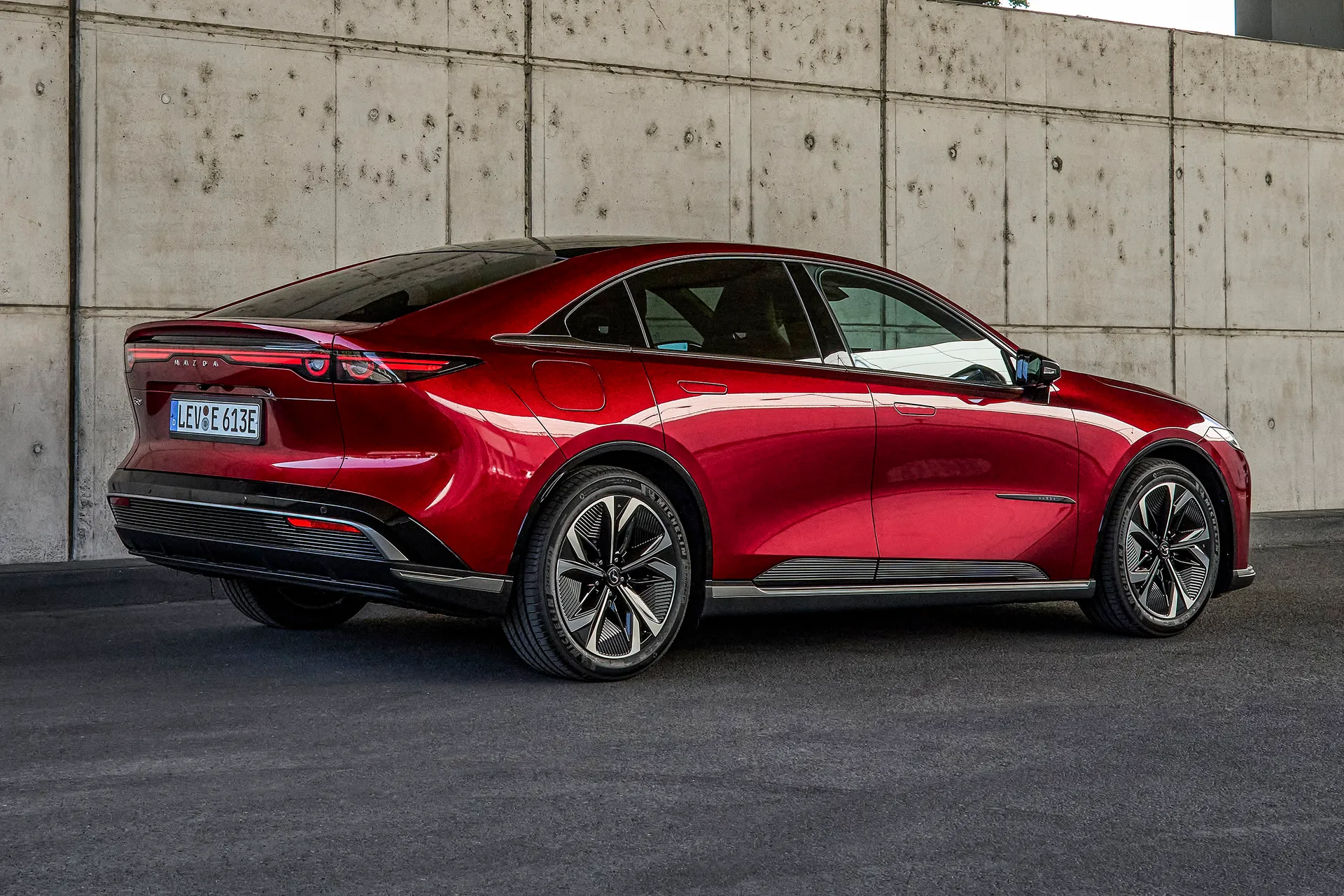
That’s because, whatever the car’s capabilities, the vast majority of UK homes don’t have the three-phase electrics needed to facilitate charging of that speed. The most that the majority of homes will be able to muster is 7.4kW, and on that more conventional type of hookup, a full charge through your home wallbox charger will be delivered in more like 11 hours on the Standard Range and 12 hours on the Long Range.
Assuming that your domestic electricity is billed at the UK’s national average price, those charges will cost you around £18 and £21, respectively. If you own an electric car, though, you’d be bonkers not to get yourself on a tariff that allows you to charge your car overnight on heavily discounted off-peak power. Do so, and you can easily slash the price of a full charge by more than half.
Conversely, you can pretty much treble that figure - and often more - if you need to utilise a DC public rapid charger. That’s because the power that comes out of those is delivered a lot more quickly, but is a lot more expensive as a result. If you’re paying a fairly typical rate of 90p per kWh to use one of these chargers, then a 10-80% charge of the Standard Range car will likely cost £58, or around £67 for the Long Range.
The bigger difference, though, is in the amount of time that rapid charge takes. Unconventionally, the Standard Range car has a maximum DC charging speed of 165kW, which makes it capable of taking on that 10-80% charge in 24 minutes. The Long Range, meanwhile, can only charge at a maximum of 90kW, and so you’ll be waiting around for a minimum of 47 minutes, plus paying a slice more for the pleasure. And those are both best-case scenarios: if your car or the charger - or both - are not running at their optimal charging rates, which they often don’t, then you’ll be waiting even longer.
Mazda 6e reliability and warranty
In the latest HonestJohn.co.uk Satisfaction Index, our go-to sources of reliability information put together by our excellent sister website - Mazda put in a rather mixed performance. The Japanese manufacturer came a rather middling 19th out of 33 car makers for overall customer satisfaction. However, in the reliability standings of the exact same survey, the brand came 9th of 33, so it would appear that where most gripes occurred, they weren’t usually about mechanical dependability.
As we’ve said, the 6e has slightly unusual origins, and that means that Mazda’s traditional reliability record is less relevant. However, because the car doesn’t even go on sale until midway through 2026, it’s all we’ve got to go on for now.
Compared to many other carmakers from the far east, Mazda offers a very uninspiring warranty package. Where others offer five-, seven-, and even ten years of cover, Mazda supplies a distinctly bog-standard three years or 60,000 miles.
Mazda 6e insurance groups and costs
The Mazda 6e won’t go on sale in the UK until midway through 2026 at the earliest, so it’s way too early to know what ballpark its insurance groups are likely to be in. We’d expect the two versions to be reasonably similar, though, given how similar their power outputs are.
VED car tax: What is the annual road tax on a Mazda 6e?
These days, you pay the same amount of annual road tax on electric cars as you do on combustion-engined cars - no discounts - so that’s what you’ll be saddled with. The flat rate of tax currently stands at £195 per year, but the Mazda 6e doesn’t go on sale until halfway through 2026, and heaven knows what the cost of VED will be by then as it tends to escalate annually.
What has remained constant for several years, though, is the £40,000 price threshold that identifies a car - in the Government’s eyes at least - as a ‘luxury car’, and thus determines whether or not that car is saddled with the luxury car surcharge. If your car costs more than that when brand new, then on top of your flat rate, you’ll also pay another £425 per year for a temporary five-year period between years two and six of the car’s life.
So, will the 6e be affected? Well, we simply don’t know yet, because prices are a long way off being announced. If we were pushed to guess, we’d estimate that the price would be somewhere around that level, so it could go either way.
Mazda 6e price
"As we’ve said, our drive of the Mazda 6e was in an early pre-production prototype, and the final production car won’t go on sale in the UK until midway through 2026. That means it's far too early for UK pricing to have even been decided, let alone communicated."
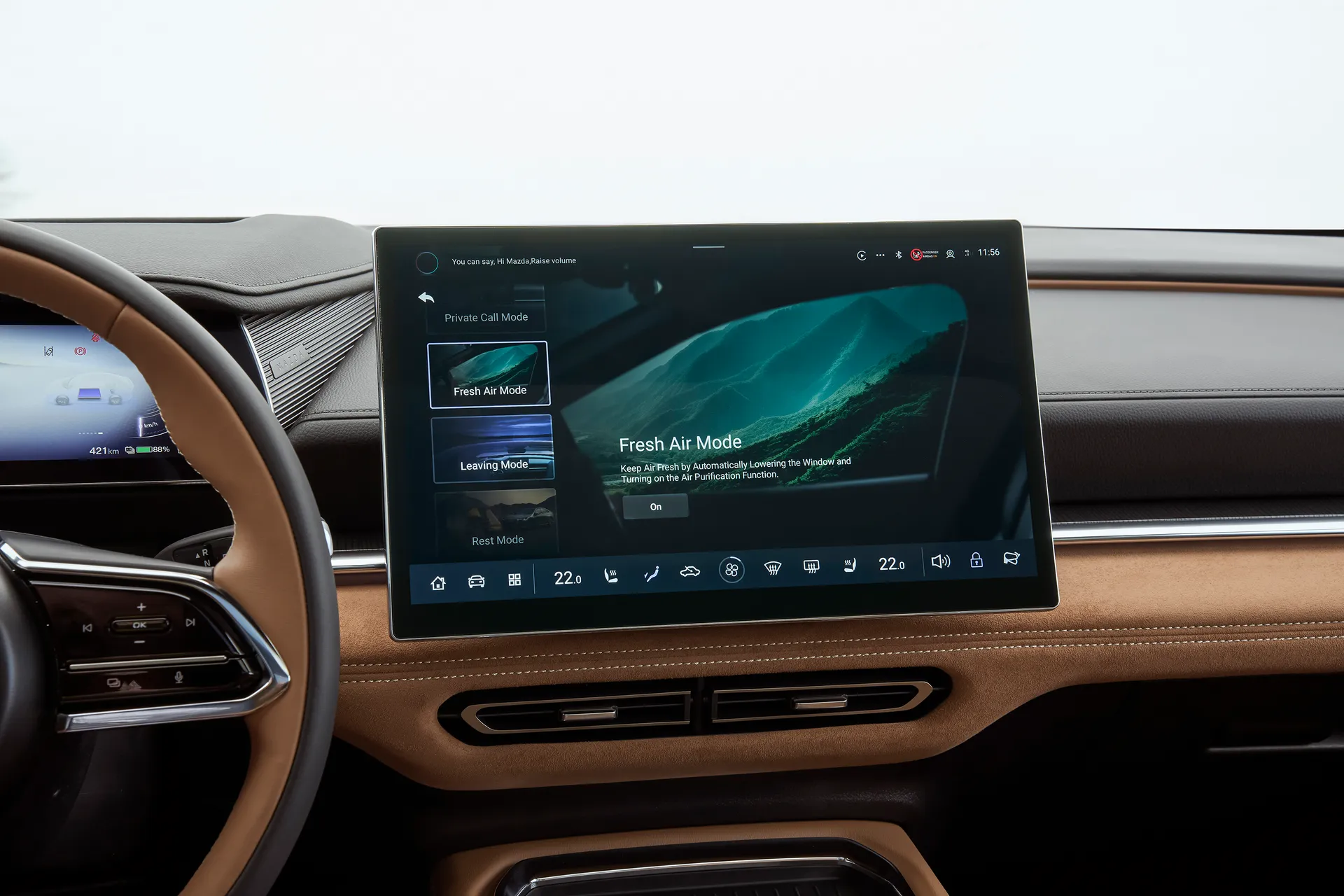
There are certain ways in which we can make an educated guess as to what the price might be, however. The car goes on sale in mainland Europe much earlier than in the UK - this September, in fact - and order books are already open. Consult Mazda’s German website, and you’ll find that the car costs around 45,000 Euros for the Standard Range car, and around 46,500 Euros for the Standard Range car. Convert those amounts using today's exchange rates, and you’re looking at prices of around £39,000 and £40,000, respectively.
Now, you certainly can’t take those amounts as gospel, because there’s far more that goes into deciding the price of a car than just that: you have to consider local taxes, exchange rates, different on-the-road costs, different supply chain implications, and many other factors.
However, if Mazda does indeed end up pricing the car somewhere around that ballpark, then it could look quite tempting. Large, all-electric family hatchbacks like this are fairly rare on today’s new-car, and most are considerably more expensive than that. For instance, the Mazda’s closest rival will arguably be the Volkswagen ID.7, and that starts at around £51,000.
Obviously, if the car hasn’t even hit the new-car market yet, then there certainly won’t be any examples to be had on the used car market. Once there are, we expect decent savings to be available pretty quickly, because residual values of large family hatchbacks like these aren’t usually all that solid, and all-electric ones even less so.
Trim levels and standard equipment
We know we’re in danger of sounding like a broken record, but the Mazda 6e doesn’t go on sale in the UK until halfway through next year, and so trim levels and equipment provision is one of the many things that are still to be decided for the UK.
We’d be surprised if specifications were vastly different to those found elsewhere in Europe, so again, we’ll look to the German market for some guidance. Over there, the base-level trim is called Takumi, and it includes alloy wheels, LED headlights with high-beam assistant, leather-effect upholstery, ambient lighting, a head-up display, dual-zone climate control, heated and cooled front seats, adaptive cruise control with traffic jam assistance, front- and rear parking sensors, 360-degree cameras, a shareable smartphone key, a powered tailgate, a panoramic roof, 14-speaker Sony sound system, and wireless phone charging.
Upgrading to Takumi Plus earns you the brown quilted leather-and-suede-effect upholstery you see in our pictures, plus a powered sunblind for the panoramic roof. Well, in Germany it does, anyway.
Ask the heycar experts: common questions
Is the Mazda 6e electric?
Is the Mazda 6e a saloon?
Should I buy a Mazda 6e?
Get our latest advice, news and offers
Keep me updated by email with the latest advice, news and offers from heycar.
By submitting you agree to our privacy policy